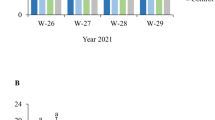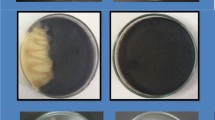Abstract
In this study, the efficacy of bacterial antagonists was tested in both pre- and post-harvest stages against Botrytis cinerea, which causes one of the major diseases of strawberries. In total, 219 bacterial antagonists were obtained from various parts of strawberry plants, and their efficacies against B. cinerea were determined. Two isolated bacteria, which were identified as Bacillus megaterium and Pseudomonas vesicularis, were found to be effective and otherwise suitable as biological control agents. Moreover, an isolate of Pseudomonas fluorescens from pea plants was successfully used against B. cinerea in the experiments. These three antagonist isolates were field- tested in both the pre- and post-harvest periods in two consecutive years. The field studies demonstrated that all three isolates were as effective as a synthetic fungicide. In the first year field tests, the isolates reduced the decay incidence to 41.08–43.03 % compared with 55.48 % in the control. Similar results were obtained in the second year. In the post-harvest stage, all the bacterial isolates also controlled the disease effectively. The bacterial population was monitored in both the pre- and post-harvest periods using a spontaneous antibiotic-resistant mutant and the RAPD-PCR method. The RAPD-PCR technique alone proved insufficient to determine the population levels of the bacterial antagonists.



Similar content being viewed by others
References
Bharathi R, Vivekananthan R, Harish S, Ramanathan A, Samiyappan R (2004) Rhizobacteria-based bio-formulations for the management of fruit rot infection in chillies. Crop Prot 23:835–843
Braun PG, Sutton JC (1987) Inoculum sources of Botrytis cinerea in fruit rot of strawberries in Ontario. Can J Plant Pathol 9:1–5
Chin AW, Bloemberg GV, van der Bij AJ, van der Drift KMGF, Schripsema J, Kroon B, Scheffer RJ, Keel C, Bakker PAHM, Tichy HV, De Bruijn FJ, Thomas-Oates JE, Lugtenberg BJJ (1998) Biological control by phenazine-1-carboxamide-producing Pseudomonas chlororaphis PCL1391 of tomato root rot caused by Fusarium oxysporum f. sp. radicis-lycopersici. Mol Plant Microbe Interact 11:1069–1077
Droby S, Chalutz EC, Wilson L, Wisniewski E (1992) Biological control of postharvest diseases: a promising alternative to the use of synthetic fungicides. Phytoparasitica 20:149–153
Elad Y, Chet I (1987) Possible role of competition for nutrient in biocontrol of Pythium damping-off by bacteria. Phytopathology 77:190–195
Ellsworth DL, Rittenhouse KD, Honeycutt RL (1993) Artifactual variation in randomly amplified polymorphic DNA banding patterns. Bio Tech 14:214–217
Emmert EAB, Handelsman J (1999) Biocontrol of plant disease: a (gram-) positive perspective. FEMS Microbiol Lett 171:1–9
Frindlender M, Inbar J, Chet I (1993) Biological control of soil-borne plant pathogens by a β-1,3 glucanase producing Pseudomonas cepacia. Soil Biol Biochem 25:1211–1221
Gore E, Altin N (2006) Growth promoting of some ornamental plants by root treatment with specific fluorescent pseudomonads. J Biol Sci 6:610–615
Guinebretiere MH, Nguyen-The C, Morrison N, Reich M, Nicot P (2000) Isolation and characterization of antagonists for the biocontrol of the postharvest wound pathogen Botrytis cinerea on strawberry fruits. J Food Prot 63:386–394
Hansen BM, Winding A (1997) Dedection of Pseudomonas putida B in the rhizosphere by RAPD. Lett Appl Microbiol 24:249–257
Jersch S, Scherer C, Schlösser E (1989) Proanthocyanidins as basis for quiescence of Botrytis cinerea in immature strawberry fruits. J Plant Dis Prot 96:365–377
Jetiyanon K, Kloepper JW (2002) Mixtures of plant growth-promoting rhizobacteria for induction of systemic resistance against multiple plant diseases. Biol Control 24:285–291
Jock S, Völksch B, Mansvelt L, Geider K (2002) Characterization of Bacillus strains from apple and pear trees in South Africa antagonistic to Erwinia amylovora. FEMS Microbiol Lett 211:247–252
Johnson KB, Stockwell VO, Mclaughlin RJ, Sugar D, Loper JE, Robert RG (1993) Effect of antagonistic bacteria on establishment of honey bee-dispersed Erwinia amylovora in pear blossoms and on fire blight control. Phytopathology 83:995–1002
Kamilova F, Validov S, Azarova T, Mulders I, Lugtenberg B (2005) Enrichment for enhanced competitive plant root tip colonizers selects for a new class of biological control bacteria. Environ Microbiol 7:1809–1817
Karabulut OA, Tezcan H, Daus A, Cohen B, Wiess B, Droby S (2004) Control of postharvest fruit rot in strawberry by Metschkowia fructicola. Biocontrol Sci Technol 14:513–521
Keel C, Schnider U, Maurhofer M, Voisard C, Laville J, Burger U, Wirthner P, Haas D, Defago G (1992) Suppression of root diseases by Pseudomonas fluorescens CHA0: importance of the bacterial secondary metabolite 2,4-diacetyl phloroglucinol. Mol Plant Microbe Interact 5:4–13
Khandka DK, Tuna M, Tal M, Nejidat A, Golan-Goldhirsh A (1997) Variability in the pattern of random amplified polymorphic DNA. Electrophoresis 18:2852–2856
Kildea S, Ransbotyn V, Khan MR, Fagan B, Leonard G, Mullins E, Doohan FM (2008) Bacillus megaterium shows potential for the biocontrol of Septoria tritici blotch of wheat. Biol Control 47:37–45
Lelliott RA, Stead DE (1987) Methods for the diagnosis of bacterial diseases of plants. Blackwell, Oxford, UK
Lima G, Ippolito A, Nigro F, Salerno M (1997) Effectiveness of Aureobasidium pullulans and Candida oleophila against postharvest strawberry rots. Postharvest Biol Technol 10:169–178
Loper JE (1988) Role of fluorescent siderophore production in biological control of Pythium ultimum by a Pseudomonas fluorescens strain. Phytopathology 78:166–172
Maas JL (1984) Compendium of strawberry diseases. The Am Phytopathological Soc, St Paul, USA
Maude RB (1980) Disease control. In: Coley-Smith JR, Verhoeff K, Jarvis WR (eds) The Biology of Botrytis spp. Academic, London, UK, pp 275–301
Nei M (1972) Genetic distance between populations. Am Nat 106:283–292
Nei M, Li WH (1979) Mathematical model for studying genetic variation in terms of restriction endonucleases. Proc Natl Acad Sci 76:5269–5273
Ongena M, Daayf F, Jacques P, Thonart P, Benhaumou N, Paulitz TC, Belanger TT (2000) Systemic induction of phytoalexins in cucumber in response to treatments with fluorescent pseudomonads. Plant Pathol 49:523–530
Páez M, Martínez-Nieto P, Bernal-Castillo J (2005) Siderophore producing Pseudomonas as pathogenic Rhizoctonia solani and Botrytis cinerea antagonists. Univ Sci 10:65–74
Paulitz TC (2000) Population dynamics of biocontrol agents and pathogens in soils and rhizospheres. Eur J Plant Pathol 106:401–413
Peng G, Sutton JC (1991) Evaluation of microorganism for biocontrol of Botrytis cinerea in strawberry. Can J Plant Pathol 13:247–257
Peng G, Sutton JC, Kevan PG (1992) Effectiveness of honey bees for applying the biocontrol agent Gliocladium roseum to strawberry flowers to suppress Botrytis cinerea. Can J Plant Pathol 14:117–129
Reguant C, Carreté R, Noemí F, Bordons A (2005) Molecular analysis of Oenococcus oeni population dynamics and the effect of aeration and temperature during alcoholic fermentation on malolactic fermentation. Int J Food Sci Technol 40:451–459
Saad MM, Saad AM, Hassan HM (2005) Biological control of the pathogenic fungus Botrytis cinerea on bean leaves by using Bacillus subtilis and Bacillus megaterium. Afr J Mycol Biotechnol 13:21–34
Snowdon AL (1990) A colour atlas of post-harvest diseases and disorders of fruits and vegetables. 1: General introduction and fruits. Wolfe Scientific, London, UK
Son YJ, Lee JP, Kim CS, Song JH, Kim HJ, Kim WJ, Kim DH, Park HC, Moon BJ (2002) Biological control of gray mold rot of perilla caused by Botrytis cinerea. Resistance of perilla cultivars and selection of antagonistic bacteria. Plant Pathol J 18:36–42
Sutton JC (1990) Epidemiology and management of Botrytis leaf blight of onion and grey mould of strawberry: a comparative analysis. Can J Plant Pathol 12:100–110
Swadling IR, Jeffries P (1996) Isolation of microbial antagonist for biocontrol of gray mould of strawberries. Biocontrol Sci Technol 6:125–136
Trotel-Aziz P, Couderchet M, Biagianti B, Aziz A (2008) Characterization of new bacterial biocontrol agents Acinobacter, Bacillus, Pantoea and Pseudomonas sp. mediating grapevine resistance against Botrytis cinerea. Environ Exp Bot 64:21–32
van De Peer Y, De Wachter R (1994) TREECON for windows: a software package for the construction and drawing of evolutionary trees for the microsoft windows environment. Comput Appl Biosci 10:569–570
van Loon LC, Bakker PAHM, Pieterse CM (1998) Systemic resistance induced by rhizosphere bacteria. Annu Rev Phytopathol 36:453–483
Wilson ME, Wisniewski CJ (1989) Biological control of postharvest diseases of fruits and vegetables: an emerging technology. Annu Rev Phytopathol 27:425–441
Yeh F, Yang RC, Boyle T (2000) Popgene (v.1.32), Microsoft Windows-based freeware for population genetic analysis. http://www.ualberta.ca/~fyeh/popgene_download.html. Accessed 20 Oct 2012
Zahavi T, Cohen L, Weiss B, Schena L, Daus A, Kaplunov T, Zutkhi J, Ben-Arie R, Droby S (2000) Biological control of Botrytis, Aspergillus and Rhizopus rots on table and wine grapes in Israel. Postharvest Biol Technol 20:115–124
Zhou T, Chu CL, Liu WT, Schaneider KE (2001) Postharvest control of blue mold and gray mold on apples using isolates of Pseudomonas syringae. Can J Plant Pathol 23:246–252
Acknowledgments
This study is partially financed by an Uludag University Scientific Research Committee project Z-2004/51 and a part of Ph.D. thesis of the first author. The authors thank the Prof. Dr. Hatice Ozaktan for critical review of the manuscript.
Author information
Authors and Affiliations
Corresponding author
Additional information
Handling Editor: Jesus Mercado-Blanco
Rights and permissions
About this article
Cite this article
Ilhan, K., Karabulut, O.A. Efficacy and population monitoring of bacterial antagonists for gray mold (Botrytis cinerea Pers. ex. Fr.) infecting strawberries. BioControl 58, 457–470 (2013). https://doi.org/10.1007/s10526-012-9503-x
Received:
Accepted:
Published:
Issue Date:
DOI: https://doi.org/10.1007/s10526-012-9503-x




